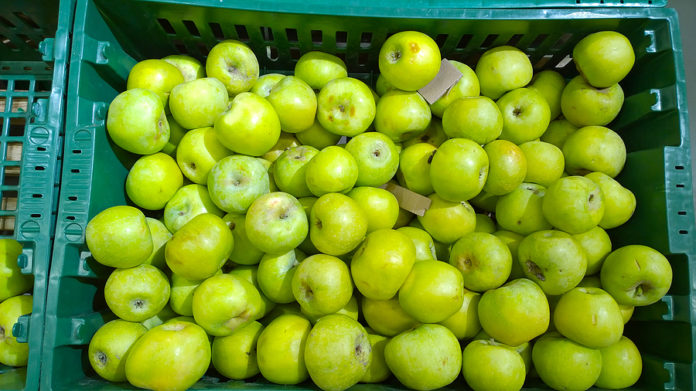
By Derek Rickard, Director of Sales, Cimcorp
Everyone along the fresh food supply chain works towards a common goal: provide safe, top-quality products to consumers. But time is of the essence when moving perishable goods. One make-or-break point in the supply chain? The warehouse or distribution center.
Within these facilities, fast and efficient fulfillment operations directly translate into a reliable supply of fresh food on store shelves. On the other hand, inefficiency leads to order delays, sub-par products, and unhappy customers. So to better manage warehouse operations, more fresh food companies and distributors are investing in automation.
Taking advantage of automation
Installed within the distribution end of fresh food production sites or in climate-controlled storage facilities, robotic solutions can optimize and control order fulfillment processes—everything from goods receiving, storage, and buffering, to picking, palletizing, loading, and dispatch. Facilities that automate, rather than solely relying on manual product handling, become up to six times more efficient and gain big advantages.
Let’s look at three of the top benefits, along with examples of leading food companies getting automation right:
Maximum product freshness
Warehouses and distribution centers that handle fresh products must meet very short lead times to minimize spoilage and maximize shelf life. After all, the less time products spend in the warehouse, the sooner they’re available to customers.
Today’s automated solutions are designed to meet the need for speed. Storage and order picking functions can be integrated into a single system, enabling rapid, end-to-end product handling for those tight lead times. Perishable goods with strict sell-by dates then reach stores as fast as possible, and customers get their money’s worth when buying fresh food.
One great example comes from grocery giant Kroger and its Mountain View Foods milk processing plant in Denver, Colorado. When building the plant, Kroger implemented an end-to-end automated warehouse solution to precisely control the entire material flow of the facility. Now Kroger is able to rapidly distribute its packaged milk, cream, and juice products to more than 160 stores—ensuring longer shelf life, optimal freshness, and satisfied customers.
Flexibility to meet demand
Demand fluctuations are a given in fresh food distribution. Some are predictable to a degree, like the seasonal surges many facilities see during the summer months and holiday season. Others are nearly impossible to anticipate, making it much harder to adapt. Just look back at the onset of COVID-19. Panicked shoppers left countless grocery store shelves empty, as distribution centers worked tirelessly to keep up with heightened demand for essential goods.
Modular automated systems can help fresh food facilities prepare for the expected and the unexpected. These systems utilize pre-engineered cells of automation that are standardized and easily repeatable. Facilities can quickly and easily scale up their levels of automation as needed to meet changes in demand, without disrupting ongoing operations.
Consider how one Midwest convenience store chain improved surge capacity through automation. In 2018, Kwik Trip opened a state-of-the-art baking facility in La Crosse, Wisconsin, to boost production volumes of its popular fresh bread and buns. The company invested in automation for efficient and well-orchestrated product flow throughout the facility. As soon as goods are baked and packaged, they enter an automated storage and retrieval system (AS/RS). Then they are picked and dispatched to stores according to a first-in-first-out (FIFO) inventory management model.
At the outbreak of the pandemic, Kwik Trip saw demand for its fresh-baked products nearly triple in a single week. But equipped with flexible automation, Kwik Trip easily maintained its usual high levels of order speed, accuracy, and freshness—despite the unexpected disruption.
Optimal labor usage
Labor shortages are common nearly everywhere, and warehouses and distribution centers are no exception. Many in the food industry are struggling to recruit and retain enough staff to keep operations running smoothly. These shortages put the most strain on facilities where employees have to manually move products in and out of storage and pick and prepare all orders by hand.
Instead, automation can take over the labor-intensive tasks involved in order fulfillment. They can run around the clock with minimal human involvement to fill any existing gaps in the workforce and maximize productivity.
In turn, human employees can move away from physically demanding roles and take on safer, more engaging positions in the warehouse. This could include supervising automated equipment, selecting picking sequences, transport planning, and system maintenance. Overall, employees will benefit from better working conditions and companies will find new savings through reduced labor costs and increased productivity.
Martin’s Famous Pastry Shoppe, Inc.®—a Chambersburg, Pennsylvania-based food manufacturer known for its potato bread and rolls—realized these benefits firsthand. After struggling with seasonal staffing during busy summer peaks, the bakery decided to automate order fulfillment in its headquarters’ warehouse. Martin’s Famous Pastry Shoppe, Inc.® implemented an automated system that stores, processes, and fulfills orders with little human intervention, reducing its labor requirements and man hours by 30%. And by moving employees away from labor-intensive positions, the bakery has
eliminated the safety risks that come along with manual order fulfillment.
Winning the race against the clock
Despite the clear benefits of automating, some fresh food companies may be hesitant to make the investment. After all, what happens if their needs change down the road and their system is unable to accommodate the changes? Fortunately, automation doesn’t have to be an all-or-nothing choice.
Flexible, modular automated solutions can be easily incorporated into new constructions or existing facility footprints. And while automation can handle the entire order fulfillment process, companies can also automate areas of the warehouse that will provide the most benefit and the biggest ROI. These “islands of automation” can be integrated with manual operations, and scaled if needed, so operations can run at their best no matter what the future brings.
Whatever approach you choose, automated solutions can give you the speed you need. Fresh food distribution is a race against the clock, and it’s time to get ahead of the game.
 As Director of Sales at Cimcorp, Derek Rickard leads the sales team in developing robotic order fulfillment solutions to meet each customer’s warehousing needs. With 20+ years of supply chain experience, Rickard has worked on many of the first fully automated robotic picking systems in North America.
As Director of Sales at Cimcorp, Derek Rickard leads the sales team in developing robotic order fulfillment solutions to meet each customer’s warehousing needs. With 20+ years of supply chain experience, Rickard has worked on many of the first fully automated robotic picking systems in North America.






